Kenneth L. Gentry Jr.'s Blog, page 101
February 18, 2016
REV 11:2: ISRAEL CAST OUT (1)
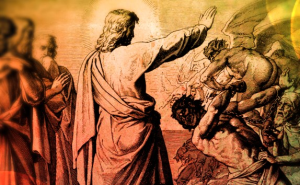 PMT 2016-014 by Kenneth L. Gentry, Jr.
PMT 2016-014 by Kenneth L. Gentry, Jr.
Rev 11:1-2 is an important passage in John’s drama about Israel’s judgment. There John receives a command to actually engage an action in his visionary experience:
“Get up and measure the temple of God and the altar, and those who worship in it. Leave out the court which is outside the temple and do not measure it, for it has been given to the nations; and they will tread under foot the holy city for forty-two months.”
As I argue elsewhere, the “temple of God and the altar” symbolizes the essence of God’s true worship and points to the true Jews (Christian Jews, Rev 2:9; 3:9) and their worship of Christ (Phil 3:3; cp. Rom 2:29; 9:6). And “the court” here is the outer court of the temple, picturing the external matters of the temple. It signifies the actual physical temple which as the heart of Israel represents the old covenant worship of Judaism and its people.
Double-entendre in John
To plumb the depth of this image, we must understand that scholars recognize John’s use of double (and even triple) entendre. According to BAGD 299, scholars recognize “the Johannine love of multiple meaning” (BAGD 299). For instance, in his Gospel we read in Jn 1:5 that the darkness did not “comprehend” the light. The word used here can mean either that the darkness did not overcome the light or the darkness did not understand the light. Both are true. We also see Jesus informing Nicodemus that he must be born “again,” which can also mean be born from “above” (Jn 3:3). “Living water” in Jn 4:10 and 7:38 can mean “running, moving water” or “water that is alive.” In Jn 11:50 the high priest says Jesus must die “for” the nation, which can mean either “in behalf of” or “instead of.” On and on we could go.
The Beast of Revelation
by Ken Gentry
A popularly written antidote to dispensational sensationalism and newspaper exegesis. Convincing biblical and historical evidence showing that the Beast was the Roman Emperor Nero Caesar, the first civil persecutor of the Church. The second half of the book shows Revelation’s date of writing, proving its composition as prior to the Fall of Jerusalem in A.D. 70. A thought-provoking treatment of a fascinating and confusing topic.
For more study materials, go to: KennethGentry.com
Such multiple significance is undeniable in Rev 17:9–10 where the beast’s heads represent both seven mountains and seven kings. This practice seems obviously at work locally in that the two witnesses somehow represent both “the two olive trees and the two lampstands” (Rev 11:4) and both Moses and Elijah (Rev 11:5–6).
Double-entendre also appears in Rev 11:2 as one of the more dramatic instances. What does the command to “leave out” mean? The word translated “leave out” here is ekballo, from ex (out of) and ballo (to throw or cast). Remembering that Revelation is speaking of God’s judgment-coming against Israel in AD 70 for her rejecting Christ, we can discern three implied meanings of the term ekballo in this pasage. I will deal with these three meanings in this and the next three articles.
The meaning of “leave out”
The foundational meaning of ekballo is: “force to leave, drive out, expel” (BAGD 299). Though it only occurs here in Revelation, John employs it in John 2:15 of Jesus casting out the money changers from the temple: exebalen ek tou hierou. In Scripture the term is used in three conceptually related ways that are of particular interest for our understanding of Revelation 11:2, each of which is found in the first definition of the term in BAGD.
The three closely related uses of ekballo all signify forceful removal of someone from a home area. As I focus on ekballo I will note that it signifies some forceful expulsion, either by means of exorcism, excommunication, or divorce. Interestingly, each of these ideas is alluded to in Christ’s original commissioning of his original disciples (one of whom is our author, John, Mt 10:2) before he sends them to the “house of Israel” (Mt 10:6): exorcism of demons (10:8, cp. v. 25); excommunication involving persecution (10:17-19, 23, 28, 34); and divorce involving home disruption (Mt 10:21, 35–36).
In this article I will focus on the use of ekballo in demon exorcism.
The idea of demon exorcism
First, Scripture very commonly uses ekballo for casting out demons (e.g., Mt 12:26, 28; Mk 1:34;16:9; cp. Josephus Ant 6:11:2 §211) from where they dwell in men as if in a house (cf. Mt 12:43-44). This is particularly remarkable given that the first woe (the fifth trumpet) has recently brought demons upon the land (9:1–11). Later an angel declares Babylon (Jerusalem) “the dwelling place of demons” (18:2). Thus, this “cast out” language becomes quite relevant to the flow of the drama.
The use of ekballo for demon exorcism is important for at least two reasons:
(1) John repeatedly notes in his Gospel that the Jewish leaders frequently charge Jesus with being in league with the devil and demons (Jn 7:20; 8:48-52; 10:20). In at least one of these cases they are responding to him for his declaring that they do not keep Moses’ Law (Jn 7:19-20). This issue even results in a major exchange with the Jews regarding the signs of the kingdom. They claim he is in league with Beelzebul (Mt 12:22-29; cp. 10:25), which leads to his warning them that the demons he is clearing out of the Land will come back and be seven times worse (Mt 12:43-45).
Navigating the Book of Revelation (by Ken Gentry)
Technical studies on key issues in Revelation, including the seven-sealed scroll, the cast out temple, Jewish persecution of Christianity, the Babylonian Harlot, and more.
See more study materials at: www.KennethGentry.com
(2) It is also significant in that John (alone among the Gospel writers) records Jesus’ charge that the Jews are of their “father the devil” who is “a liar from the beginning” (Jn 8:44). Jesus effectively repeats this in Rev when he twice calls the Jewish synagogue a “synagogue of Satan” and charges the Jews with lying about their claim (2:9; 3:9). The outpouring of demons on the land in Rev 9 is just as Jesus warns in Mt 12:45b (cf vv. 43-45a). The verb ekballo in Rev 11:2 echoes Christ’s concern in a startling way: Whereas he cast out demons, their temple (“your house,” Mt 23:38) is to be cast out itself.
Demon exorcism is an important element in Jesus’s ministry in Israel in that his kingdom is invading Satan’s. He specifically commissions his disciples to cast out demons (Mt 10:1, 8) when they are sent into Israel (Mt 10:5-6). In that context he speaks of those Jewish cities rejecting his disciples and their exorcism ministry, warning: “Truly I say to you, it will be more tolerable for the land of Sodom and Gomorrah in the day of judgment, than for that city” (Mt 10:15). Interestingly, our context calls Jerusalem “Sodom” (11:8). In that Israel is in league with Satan, she herself will be cast out (as represented here by the outer court of her temple being cast out).
Interestingly, a major back-theme in Rev is the demise of Satan (e.g., 12:9; 20:2, 10), while John focuses on Israel’s judgment (1:7). In his Gospel we read Jesus associating Satan’s overthrow with his own death, which the Jews cause (Jn 19:6-7, 11-12, 15). Despite the evil effort of Satan and Israel, Christ’s death will lead to a new era in which “all men” — not Jews alone — will be drawn to Christ: “Now judgment is upon this world; now the ruler of this world shall be cast out [ekblethesetai exo]. And I, if I be lifted up from the earth, will draw all men to Myself” (Jn 12:31-32; cp. exposition of Rev 7:9ff). The casting out of the temple (11:2) is spoken of in similar terms. Again, instead of demons being cast out of the Jews, their beloved temple will be cast out from the world and from God’s presence.
Thus, it seems John’s double-entendre here involves Israel’s being cast out of her temple as if by means of demon exorcism. But there is more! See you soon.









February 15, 2016
WHEN ARE THE “LAST DAYS”?
 PMT 2016-012 by Kenneth L. Gentry, Jr.
PMT 2016-012 by Kenneth L. Gentry, Jr.
A reader writes:
“What are the “last days” in Scripture? Some see this as referring to the last days of the old covenant administration. But others understand this as referring to the whole period between the first and second advents, i.e., all of church history.”
I will offer a succinct explanation of what I (and the majority of non-dispensational) theologians holds.
First, by the very nature of the phrase, “the last day,” we should expect that it occurs at at the end of the period known as the “last days.” But the “last day” has as its defining feature the final bodily resurrection of the dead. Therefore, it cannot be the end of the old covenant at AD 70.
“And this is the will of Him who sent Me, that of all that He has given Me I lose nothing, but raise it up on the last day. “For this is the will of My Father, that everyone who beholds the Son and believes in Him, may have eternal life; and I Myself will raise him up on the last day.” John 6:39-40
“No one can come to Me, unless the Father who sent Me draws him; and I will raise him up on the last day. John 6:44
Martha said to Him, “I know that he will rise again in the resurrection on the last day.” John 11:24
As It Is Written
by Ken Gentry
This book provides in a simple but clear presentation the basic argument for a six-day literal interpretation of Genesis 1. It also explains and rebuts the framework hypothesis.
See more study materials at: www.KennethGentry.com
Second, in fact, the “end of the age” will witness the final judgment as well as the resurrection.
“The enemy who sowed them is the devil, and the harvest is the end of the age; and the reapers are angels. Therefore just as the tares are gathered up and burned with fire, so shall it be at the end of the age. The Son of Man will send forth His angels, and they will gather out of His kingdom all stumbling blocks, and those who commit lawlessness, and will cast them into the furnace of fire; in that place there shall be weeping and gnashing of teeth. Then the righteous will shine forth as the sun in the kingdom of their Father. He who has ears, let him hear.” Matthew 13:39-43
“Again, the kingdom of heaven is like a dragnet cast into the sea, and gathering fish of every kind; and when it was filled, they drew it up on the beach; and they sat down, and gathered the good fish into containers, but the bad they threw away. So it will be at the end of the age; the angels shall come forth, and take out the wicked from among the righteous, Matthew 13:47-49
Third, the “last days” period will experience a glorious time of worldwide peace and righteousness, wherein the world will lay aside its warring ways. This obviously has not occurred yet. Therefore, the “last days” must be at least partly still in our future.
“Now it will come about that / In the last days, / The mountain of the house of the Lord / Will be established as the chief of the mountains, / And will be raised above the hills; / And all the nations will stream to it. / And many peoples will come and say, “Come, let us go up to the mountain of the Lord, / To the house of the God of Jacob; / That He may teach us concerning His ways, / And that we may walk in His paths.” / For the law will go forth from Zion, / And the word of the Lord from Jerusalem. / And He will judge between the nations, / And will render decisions for many peoples; / And they will hammer their swords into plowshares, and their spears into pruning hooks. / Nation will not lift up sword against nation, / And never again will they learn war.” (Isaiah 2:2-4).
Micah puts it even more vigorously:
“And it will come about in the last days / That the mountain of the house of the Lord / Will be established as the chief of the mountains. / It will be raised above the hills, / And the peoples will stream to it. / And many nations will come and say, “Come and let us go up to the mountain of the Lord / And to the house of the God of Jacob, / That He may teach us about His ways / And that we may walk in His paths.” / For from Zion will go forth the law, / Even the word of the Lord from Jerusalem. / And He will judge between many peoples / And render decisions for mighty, distant nations. / Then they will hammer their swords into plowshares / And their spears into pruning hooks; / Nation will not lift up sword against nation, / And never again will they train for war. / And each of them will sit under his vine / And under his fig tree, / With no one to make them afraid, / For the mouth of the Lord of hosts has spoken.” (Micah 4:1-4)

Before Jerusalem Fell
by Ken Gentry
My doctoral dissertation defending a pre-AD 70 date for Revelation’s writing
See more study materials at: www.KennethGentry.com
Fourth, Paul tells Timothy (around AD 67) that “difficult times will come” (2 Tim 3:1) in “the last days.” This does NOT suggest that “the entire New Covenant Age” can be construed as “terrible times.”
Rather, it tells us two things: (1) The last days will not be totally and universally a period of good time. The word for time is not singular, but plural. After all, “difficult times will come” during the “last days.” He does not say “the last days will be a difficult time.”
But also we learn that: (2) those “difficult times” represent many punctuations during the “last days.” That is, though the gospel of the kingdom will grow to conquer the world, it must experiences episodes (plural) of “difficult times.” And those “difficult times” are not just for the paltry period of only forty years, but extending over many “difficult times,” even up to our time and beyond. These difficult times will gradually fade as the full glory of the kingdom overwhelms the world (as a gradually growing mustard seed, as slowly permeating leaven, as a sprouting seed (Mark 4; Matthew 13).
Thus Paul’s statement regarding “difficult times” informs us that there will be periods (plural) of bad times in the “last days.” These periods suggest a longer period than forty years, and well describe history to this point.
Fifth, Peter signifies that the last days cover a long period of time.
(1) The thrust of the book seems to promote a spiritual perseverance in anticipation of the historical long run – a long run that ends up in the eternal new creation. Peter urges the perseverance of his readers (1 Pet. 1:6) and warns against short-sightedness (1:9). It is only through long-term perseverance that we may expect access to the eternal kingdom of Jesus Christ (1:11). Peter himself expects to die soon (1:13-14; as did Paul, 2 Tim. 4:6-8). Consequently, he urges his readers to recall these things after he is gone (1:15), apparently not expecting a rapture of the Church in A.D. 70 (as per radical preterists).
Peter gives Noah and Lot as examples of those who persevered through hard times, like those facing the looming destruction of Jerusalem. They came out on the other end still upon the earth (2:5-9). The rescue of believers from the oncoming temptation (2:9a) associated with A.D. 70 (by preserving them in trial, Luke 21:18-22) is set in contrast to the reserving of the fallen angels and the ungodly until the (later) Judgment Day (2:4, 9b). While contemplating the judgment cleansing of the earth, we are urged to “holy livings” and “pieties” (Greek plurals of these words occur only here, 3:11), suggesting many acts of righteousness for the long term. The book ends with a call to perseverance, as well (3:15, 17).
(2) The mockers scoff at the promised second advent of Christ due to the long wait associated with it (2 Pet. 3:3-4, 9). Despite the trials to come soon (2:9), Peter even suggests it may be thousands of years before Christ’s return, in that the delay is based on God’s time rather than man’s: “But, beloved, do not forget this one thing, that with the Lord one day is as a thousand years, and a thousand years as one day” (3:8). This fits well with Christ’s “now/not yet” teaching elsewhere, where He contrasts the short time until the destruction of Jerusalem (Matt. 23:36; 24:34) with that of the long wait for the second advent to end history (Matt. 25:5, 14).
(3) The longsuffering of the Lord is due to a process necessarily age-long: “The Lord is not slack concerning His promise, as some count slackness, but is longsuffering toward us, not willing that any should perish but that all should come to repentance” (2 Pet. 3:9 NKJV). “Account that the longsuffering of our Lord is salvation” (2 Pet. 3:15a). The process of calling the “all” to “repentance” unto salvation spans the entire inter-advental era and is still continuing today. This “slowness” (bradutes, v. 9) of Christ’s second advent is so that the postmillennial kingdom victory might continue to grow unto full fruition.
In verse 12a Peter urges Christians to “hasten (speudo, “speed up”) the coming of the day of God” (3:12). Vincent comments: “I am inclined to adopt, with Alford, Huther, Salmond, and Trench, the transitive meaning, hastening on; i.e., `causing the day of the Lord to come more quickly by helping to fulfill those conditions without which it cannot come; that day being no day inexorably fixed, but one the arrival of which it is free to the church to hasten on by faith and by prayer.’ “4 This is in keeping with “the cumulative evidence from Scripture, inter-testamental literature, and Jewish sources” regarding the term speudo. The way that we “hasten the coming of the day of God” (3:12) is by evangelistic endeavor. Hence, the earnest prayer “Thy kingdom come, thy will be done on earth as it is in heaven” (Matt. 6:10; cf. Acts 3:19ff).
(4) The reference to the unraveling and conflagration of the heavens and the earth is expressly tied to the material creation. Hence, it refers to the consummation and not to A.D. 70, despite certain similarities. Peter expressly refers to the material creation order: “from the beginning of creation” (3:4; cf. Gen. 1:1); “by the word of God the heavens were of old, and the earth standing out of water and in the water” (3:5; cf. Gen. 1:2, 97); “the heavens and the earth which now exist” (2 Pet. 3:7). He defines the “heavens and earth” to which he refers. He is not contemplating the destruction of the old Jewish order, but the material heavens and the earth.
(5) The strong detailed language of the destruction of the heavens and the earth seems to go beyond apocalyptic imagery, referring to the actual consummation: “the heavens will pass away with a great noise, and the elements will melt with fervent heat; both the earth and the works that are in it will be burned up” (2 Pet. 3:10). “The heavens will be dissolved being on fire, and the elements will melt with fervent heat” (3:12). In the apocalyptic-symbolic passages thought to parallel 2 Peter 3 we find time frame factors and cultural limitations. Neither does this destruction terminology appear in Isaiah 65:17ff, where the phrase “new heavens and new earth” first appears.
In the final analysis, we must look at “last days” as “the last days of earth history.” They obviously will include that end-time period, but “the last days” is a redemptive-historical phrase. It focuses on Christ as the dividing point in history. All that went before (the old covenant) was the “former days.” That which comes after is the “latter / last days” (Heb 1:1-2). We need to interpret the phrase not in terms of mundane temporal history, but in terms of the progress of redemptive history.
Click on the following images for more information on these studies:











February 11, 2016
REVELATION’S 42-MONTH WAR
 PMT 2016-012 by Kenneth L. Gentry, Jr.
PMT 2016-012 by Kenneth L. Gentry, Jr.
Revelation must be understood preteristically. That is, we must recognize that John was primarily writing about the Jewish War which led to the September AD 70 destruction of the Jewish temple and the conclusion of biblical (Torah-based) Judaism.
In Rev 11:1–2 we read a much debated passage: “There was given me a measuring rod like a staff; and someone said, ‘Get up and measure the temple of God and the altar, and those who worship in it. Leave out the court which is outside the temple and do not measure it, for it has been given to the nations; and they will tread under foot the holy city for forty-two months.’”
The time-frame of forty-two months has been a large focus of this interpretive debate. Most commentators see this period as either speaking of a brief time of tribulation toward the end of history (G. E. Ladd; G. Beasley-Murray; R. Mounce; B. Witherington; G. R. Osborne), or as symbolic for the whole of Christianity’s historical experience until the end (J. P. M. Sweet; L. Morris; S. Kistemaker; C. Keener; J. L. Resseguie; V. Poythress). Most preterists recognize this period as referring to the period of the first-century Jewish War with Rome (M. Stuart; J. S. Russell; A. Clarke; D. Clark; J. M. Ford; J. M. Court; J. E. Adams; D. E. Aune; M. Barker; M. Wilson)—though, surprisingly, not M. S. Terry or D. Chilton.
Four Views on the Book of Revelation
(ed. by Marvin Pate)
Helpful presentation of four approaches to Revelation. Ken Gentry writes the chapter on the preterist approach to Revelation, which provides a 50 page survey of Revelation.
See more study materials at: www.KennethGentry.com
We must recognize that the Revealer (1:1; cp. 11:1, 3) of the symbolic time-frame is also the Governor of temporal history (4:11; 5:13; 10:6). And he promises that his word “will not return to Me empty, / without accomplishing what I desire” (Isa 55:11). Consequently, a direct correspondence may well exist between revelational declaration and historical execution, between symbolical image and temporal incident. In fact, in the Old Testament, forty-two months represent the literal period of God’s chastening Israel for worshiping Baal (1Ki 16:29–18:46) and Babylon’s siege of Jerusalem under Zedekiah’s reign (Jer 52:4–5). We find this same time period in Antiochus Epiphanes’ oppression of the Jews (Da 7:25; 12:7). Josephus (J.W., Pref., 1:1:32–33; cp. 5:5 §397) notes that Antiochus “took their city (Jerusalem) by force . . . and put a stop to the constant practice of offering a daily sacrifice for three years and six months.”
Providentially then, this forty-two month period actually does conform very closely to the length of the Jewish War that ended with the destruction of “the holy city” and the temple. And this is not merely a “curious coincidence” (P. Carrington). The Jewish War unfolded as follows.
In AD 66, after a dreadful period of procuratorial incompetence, Israel revolted against her oppressive Roman governor Gessius Florus. By late October / early November, C. Cestius Gallus (the Roman legate of the Syrian province which included Judaea) led a Roman military force to Jerusalem in an attempt to put down the uprising. He assembled “an army of over thirty thousand men in Antioch—the whole of one of the Syrian legions, XII Fulminata, and vexillations from the others, ten auxiliary units, and large contingents supplied by Agrippa, who led his force in person, and two other client kings, Antiochus IV of Commagene and Sohaemus of Emesa” (M. Smallwood). But after surrounding Jerusalem, he unexpectedly withdrew for reasons that are unclear (J.W. 2:18:9–19:9 §499–555; Tacitus, Hist. 5:10). His withdrawal was disastrous, encouraging the Jews in their revolt by giving them hope of success against Rome (J.W. 6:6:2 §341). This transformed the regional revolt against the procurator Gessius Florus into a full-scale war against the emperor Nero Caesar.
Thus, “such was the situation when Nero, in February 67, appointed Titus Flavius Vespasianus with the rank of legatus to carry on the war” (Cambridge Ancient History). M. Bunson states that Vespasian “was given command of the legions in Palestine in February 67, the rank of governor of Judaea, and the task of suppressing the revolt of the Jews.” John would likely count the beginning of the war from the time that the white horseman actually “went out [ex lthon]” to conquer (6:2), that is, when Vespasian initially entered Israel to engage military operations. Shortly thereafter, “the war began in earnest only in March or April of 67, when Vespasian and his son Titus gathered their legions in Ptolemais. By July of the same year, Jotapata had fallen and Josephus was in chains. Jerusalem would not fall until September of 70.”
Nourishment from the Word
(by Ken Gentry)
Reformed studies covering baptism, creation, creeds, tongues, God’s law, apologetics, and Revelation See more study materials at: www.KennethGentry.com
T. Parry writes that Vespasian made war from “roughly April 67 at Ptolemais [J.W. 3.29] until the fall of Jerusalem in September 70 (J.W. 6.407; 435), a period of three and a half years.” N. Faulkner observes that “the Jewish Revolution against Rome ended, to all intents and purposes, when, on 7 September, the morale of the militiamen, who had struggled so hard for so long, suddenly collapsed.” Though Masada remained unconquered until 73, the conquerors officially treated the war as over, and Vespasian and Titus returned to Rome and celebrated a magnificent Triumph. This was because “from the practical standpoint, after the fall of Jerusalem all else were mopping-up operations” (R. H. Worth).
Considering the above scenario, M. Stuart correctly observes that “the active invasion of Judea continued almost exactly this length of time, being at the most only a few days more; so few that they need not and would not enter into a symbolical computation of time.” M. Barker (186) agrees that this figure represents “the duration of the final struggle with Rome [for] Vespasian entered Galilee with his armies in the Spring of 67 CE (War 3:29-34) and Jerusalem fell forty-two months later, in September 70 CE.”
Thus, we see that from Spring of AD 67 to August/September of AD 70, the time of formal imperial engagement against Jerusalem, is a period right at forty-two months. J. Court (87) speaks of “the period of the Flavian war, from the spring of AD 67 to 29 August 70, during which time Jerusalem was ‘profaned.’” Even in Rabbinic tradition we read: “for three and a half years Vespasian surrounded Jerusalem” (Lam. R. 1:31). Of course, all of this fits perfectly within Revelation’s temporal limits (1:1, 3; 22:6, 10).
Click on the following images for more information on these studies:



February 8, 2016
ARE PRETERISTS REALLY FUTURISTS?

PMT 2016-011 by Kenneth L. Gentry, Jr.
In the last thirty years the Hyper-preterist movement has made its presence felt in a number of evangelical churches. But it is has developed an especially strong Internet presence that has been able to attract hundreds of theological enthusiasts. In fact, it is largely through its Internet presence that it has been able to grow in numbers, spread in geography, and infiltrate in churches.
Hyper-preterism (or Full Preterism or Consistent Preterism or Covenant Eschatology, as it is known by its adherents), is an extension of preterism. But it is an extension that has pushed its theology beyond biblical limits.
Preterism holds that there are a number of passages in the NT that refer to the destruction of Jerusalem, even though many Christians have viewed these as referring to the time of the second advent. Preterists derive this understanding from the express statements of Scripture, statements declaring that the events will occur in “this generation,” because “the time is near,” “soon,” and so forth.
Keys to the Book of Revelation
(DVDs by Ken Gentry)
Provides the necessary keys for opening Revelation to a deeper and clearer understanding.
See more study materials at: www.KennethGentry.com
Hyper-preterism, though, uses these passages as a leaping-off point, building its innovative theology on these passages and applying temporal limitations where they do not appear. They believe that all Bible prophecy was fulfilled by AD 70. They hold that the time of the AD 70 destruction of the temple experienced the second coming of Christ, the great judgment, the resurrection of the dead, and more.
By departing from the universal, historic, formal, corporate, public, systematic belief of the Christian faith in these areas, Hyper-preterism has constructed a new, aberrant theology. Hyper-preterists have radically reworked the Christian doctrinal system and overthrown the faith once for all delivered to the saints.
Interestingly, Hyper-preterists are so enamored with their system that they like to use the word “futurism” as a pejorative put-down for historic, orthodox preterists. That is, since orthodox preterism holds to a future second coming, bodily resurrection, and final judgment, Hyper-preterists loudly declaim it as actually being a futurist system.
This charge of futurism is erroneous on two counts.
First, “futurism” is a widely-used, well-known term that has historically spoken of a specific eschatological commitment to a future, literal establishment of the millennial reign of Christ. Futurism has for a long time been defined by noted Christian theologians. It has not been left to the Hyper-preterist movement to define. Their employment of this term as a put-down for orthodox preterists is uncalled for.
And if it were legitimate to deride orthodox preterists as “futurists” because they accept future elements in their eschatology, then it ought to be the case that dispensationalist futurists ought to be called “preterists” because they recognize certain prophecies were preteristically fulfilled in AD 70. For instance, they understand that Luke 21:20–24 prophetically points to AD 70.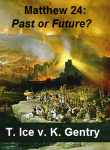
Matthew 24 Debate: Past or Future?
(DVD by Ken Gentry and Thomas Ice)
Two hour public debate between Ken Gentry and Thomas Ice on the Olivet Discourse.
See more study materials at: www.KennethGentry.com
Second, interestingly one of the most important Hyper-preterists was J. Stuart Russell (1816–1895). His large and impressive work The Parousia (1887) was resurrected (!) in 1987 by Baker Book House and has been a standard text of the Hyper-preterist movement that developed after its republication. And Russell is clearly a Hyper-preterist (a modern designation) in that he held to the key commitments of this new movement: the AD 70 destruction of the temple witnessed the second coming of Christ, the great judgment, and the resurrection of the dead.
Nevertheless, in this primary document of the Hyper-preterist movement we discover “futurist” elements by this champion of preterism (i.e., Hyper-preterism). Let me demonstrate this.
In speaking of the loosing of Satan (Rev 20:7–10), Russell writes:
“It is evident that the prediction of what is to take place at the close of a thousand years does not come within what we have ventured to call ‘apocalyptic limits.’ These limits, as we are again and again warned in the book itself, are rigidly confined within a very narrow compass; the things show are ‘shortly to come to pass.’ It would have been an abuse of language to say that events at the distance of a thousand years were to come to pass shortly; we are therefore compelled to regard this prediction as lying outside the apocalyptic limits altogether.” (Parousia, 522).
He continues in the next paragraph: “We must consequently regard this prediction of the loosing of Satan, and the events which follow, as still future and therefore unfulfilled.” On the next page (p. 523) he adds: “This we believe to be the sole instance in the whole book of an excursion into distant futurist; and we are disposed to regard the whole parenthesis as relating to matters still future and unfulfilled.”
Then as he closes his book, he declares very clearly his postmillennial hope for the conversion of the world — an unfulfilled prophetic hope. Speaking of statements by the apostle Paul, Russell (pp. 553, 554) notes:
“He does not hesitate to affirm that the restorative work of Christ will ultimately more than repair the ruin wrought by sin…. We are happy to be assured of the consummation on higher and safer grounds, even the promises of Him who has taught us to pray, ‘Thy will be done in earth, as it is done in heaven.’ For every God-taught prayer contains a prophecy, and conveys a promise. This world belongs no more to the devil, but to God. Christ has redeemed it, and will recover it, and draw all men unto Him. Otherwise it is inconceivable that God would have taught His people in all ages to utter in faith and hope that sublime prophetic prayer: — “God be merciful unto us, and bless us; And cause his face to shine upon us; They thy way may be known upon earth, Thy saving health among all nations. … And all the ends of the earth shall fear him.’”
Here he is citing from Psalm 67.
Should Russell should then be written-off as an futurist?
Click on the following images for more information on these studies:

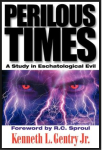









February 4, 2016
THE MILLENNIUM EXAGGERATED (2)
 PMT 2016-010 by Kenneth L. Gentry, Jr.
PMT 2016-010 by Kenneth L. Gentry, Jr.
This is the second and concluding study on the exaggerated role of the millennium in eschatological studies. It is important for you to read the preceding article before jumping into this one. I am arguing that John’s half-chapter is given too much place in prophetic discussions. This has led many Christians to misunderstand the function of the millennium in Revelation, as well as its length.
Properly understood, the thousand-year time frame in Revelation 20 represents a long and glorious era and is not limited to a literal 365,000 days. The figure represents a perfect cube of ten, which is the number of quantitative perfection (as Augustine argues long ago). The thousand here is no more literal than that which affirms God’s ownership of the cattle on a thousand hills (Ps 50:10), or promises Israel will be a thousand times more numerous (Dt 1:11), or measures God’s love to a thousand generations (Dt 7:9), or expresses the desire for a thousand years in God’s courts (Ps 84:10), or compares a thousand years of our time to one of God’s days (Ps 90:4). Terry even surmises that “it may require a million years.”
Blessed Is He Who Reads: A Primer on the Book of Revelation
By Larry E. Ball
A basic survey of Revelation from the preterist perspective. It sees John as focusing on the destruction of Jerusalem and the temple in AD 70.
See more study materials at: www.KennethGentry.com
The millennial designation, then, is John’s visionary portrayal of Christ’s kingdom, which the Lord establishes at his first coming. Revelation 20:1 clearly presents the passage as a vision; John opens with: “and I saw” (Rev 20:1a). This strongly suggests its symbolic import and is evidence against a strictly literal interpretation of the one thousand years. In addition, the first event we see in the vision is Satan’s binding with a chain, which surely is not literal (especially since his binding appears as a spiritual event elsewhere: Mt 12:29). And what kind of key would unlock “the abyss” (Rev 20:1)? And where would it be kept? Surely the key is a symbol of control, as when Christ holds “the keys of death and of Hades” (Rev 1:18). May we really imagine that the Lord holds physical keys that control death and Hades?
Revelation 20:4–6 speaks of the saints living and reigning with Christ, which appears elsewhere as a spiritual reality in the present experience of God’s people (1Co 3:21–22; Eph 1:3; 2:6; Col 3:1–2). In Revelation 20:6 we read that “they will be priests of God and of Christ and will reign with Him for a thousand years,” whereas in Revelation 1:6 John applies this same imagery to John’s first century audience: “He has made us to be a kingdom, priests to His God and Father.” This reigning of the saints with Christ on thrones pictures the kingdom of Christ, which is already established (cf. ch. 10). His kingdom, then, is defined chronologically as a complete and perfect, long-lasting period. Warfield approvingly cites William Temple: “The church is still in its infancy. Two thousand years are as two days.” As James Adderley expresses it: “Christianity is a very young religion” and “we are only at the beginning of Christian history even now.”
Down But Not Out
by Wayne A. Mack
Wayne Mack brings biblical counsel to people suffering from worry or spiritual burnout—two major problems that knock us down. Other chapters treat “downers” such as self-pity, discontentment, discouragement, perplexity, and hopelessness.
See more study materials at: www.KennethGentry.com
Besides, elsewhere Christ’s second coming occurs at “the end” (1Co 15:23–24) and brings in “the last day” resurrection (Jn 6:39, 40, 44, 54). “Therefore, in view of the total absence of supporting evidence from the New Testament, it is exceedingly hazardous to claim that a thousand years intervene between Christ’s coming and the end of the world on the grounds that Revelation 20 teaches a millennium.”
The millennial era has already lasted almost 2,000 years; it may continue another 10,000 or more for all we know. It is the perfect time of Christ’s rule in his kingdom (Rev 1:5–6) — a time that shall eventually result in the subduing of all nations.
Now that we have had this two-part study of the abuse of the millennium: “Go. And sin no more.”
Click on the following images for more information on these studies:











February 1, 2016
THE EXAGGERATED MILLENNIUM
 PMT 2016-009 by Kenneth L. Gentry, Jr.
PMT 2016-009 by Kenneth L. Gentry, Jr.
I am beginning a two-part series on the millennium. I will be highlighting how its significance in eschatological discussions is exaggerated. I am calling for balance on this issue.
Revelation 20:1–6 present us with a time frame that plays a far greater role in the eschatological debate than it warrants. Oddly, Stanley J. Grenz asserts of “evangelical postmillennialists” that “as a millenarian viewpoint, of course, it builds its primary case from a futurist interpretation of John’s vision.” This is simply not so. As I show in chapter 3 and argue in my chapter in Three Views on the Millennium and Beyond, “I would prefer to leave Revelation 20 out of my presentation.” In their debate book Antony Hoekema scolds postmillennialist Loraine Boettner for not dealing with Revelation 20:1–6 in his argument for postmillennialism.
Incredibly, this passage dominates the thinking of various eschatological schools. But amillennialist William Cox wisely argues: “Most millennial thinking begins with Revelation 20, since this is the only place in the entire Bible where the thousand years is mentioned. We feel that Revelation 20 ought to be our last stop, not our first.” Indeed, “this is one of the most hotly debated issues in the whole field of eschatology.” Grant Osborne reminds us that “few issues have divided the church for as long a time as this, for the church in the first three centuries had extensive debates over ‘chiliasm.’”
Adam in the New Testament
by J. P. Versteeg
Carefully examining key passages of Scripture, Versteeg proves that all human beings descended from Adam, the first man. He argues that if this is not true, the entire history of redemption documented in Scripture unravels and we have no gospel in any meaningful sense.
See more study materials at: www.KennethGentry.com
The role of Revelation 20 in the debate is absolutely essential to premillennialism. Historic premillennialist Timothy P. Weber notes that “the key biblical passage for such [golden age] speculation is Revelation 20, in which Christ returns to earth, defeats Satan, and sets up a thousand-year kingdom on the earth.” Premillennialist Craig L. Blomberg agrees: “for evangelical New Testament interpreters, the millen-nial debate reduces ultimately to an understanding of Revelation 20.” He notes that: “George Eldon Ladd . . . liked to say in class that he could have been an amillennialist if it were not for Revelation 20.”
Premillennialism’s depending on Revelation 20 is surprising for at least two major reasons. First, the only place in all of Scripture that associates “one thousand years” with the reign of Christ is in the first six verses of this one chapter. Against such a complaint, premillennialist Ladd comments: “the fact that the New Testament in only one place teaches an interim kingdom, between this age and the Age to Come is no reason for rejecting it.” Yet the postmillennial concern is well-justified. If a literal earthly millennium is a prominent era in redemptive history, the very goal of history (as premillennialists and dispensationalists argue), then why should we not expect a reference to the thousand years appearing in more than one passage?
Second, the thousand-year reign occurs in the most figurative and difficult book in all of Scripture. If it is a literal time frame, why is it that it is only mentioned in this highly symbolic book? It is a bit odd, too, that this time frame is a perfectly rounded and exact multiple of ten, which seems more compatible with a figurative view.
B. B. Warfield is surely correct when he comments: “we must not permit ourselves to forget that there is a sense in which it is proper to permit our understanding of so obscure a portion of Scripture to be affected by the clearer teaching of its more didactic parts. . . . The order of investigation should be from the clearer to the more obscure.” But dispensationalists and premillennialists seldom honor this hermeneutical principle. In fact, “nothing, indeed, seems to have been more common in all ages of the Church than to frame an eschatological scheme from this passage, imperfectly understood, and then to impose this scheme on the rest of Scripture vi et armis.”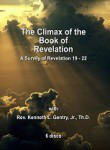
The Climax of the Book of Revelation (Rev 19-22)
Six lectures on six DVDs that introduce Revelation as a whole, then focuses on its glorious conclusion. Provides an important, lengthy Introduction to Revelation also.
See more study materials at: www.KennethGentry.com
Historic premillennialist Chung complains: “Many Reformed theologians . . . spiritualize key passages of the Bible that must be interpreted more literally from the kingdom perspective. For example, many Reformed covenant theologians have taken Revelation 20:1–6 as a metaphorical account, denying the fulfilment of the physical millennial rule on the earth.”
Robert Clouse well notes: “These categories [amillennial, premillennial, postmillennial], although helpful and widely accepted, are in certain respects unfortunate as the distinctions involve a great deal more than the time of Christ’s return.” Nevertheless, as I note above, amillennialist Hoekema scolds postmillennialist Boettner for not dealing with Reve-lation 20:1–6 in his presentation of the postmillennial conception of the kingdom.
To be continued. Don’t worry the Rapture hasn’t happened. I will be back.
Click on the following images for more information on these studies:
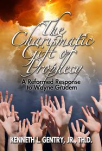
January 28, 2016
ESCHATOLOGY AND WORLDVIEW ELEMENTS
 PMT 2016-008 by Kenneth L. Gentry, Jr.
PMT 2016-008 by Kenneth L. Gentry, Jr.
Holding and understanding a worldview is an important function of the Christian faith. But what is a worldview? The core concept of a worldview may be expressed in a simple, one-sentence definition:
“A worldview is a conceptual framework through which we understand the world and our life in it.”
We can easily see why this is a little more fully called: a “world-and-life view” in that it provides an organizing outlook on both our own lives as well as the world round about us.
The essential presuppositions undergirding the Christian worldview and its view of history include the following key concepts: God, creation, providence, fall, redemption, revelation, and consummation.
God
A proper view of history, its meaning, and purpose requires a proper view of God. God exists and is absolutely independent and wholly self-sufficient. In Exodus 3:14 he defines himself by his special covenantal name “YHWH” (“Yahweh / Jehovah”). This is his name “forever” (Exo 3:15). It is so prominent that the Scriptures can simply mention “the name” (Lev 24:11, 16). God jealously establishes a fundamental moral law that his name must not be used in vain (Exo 20:7; Deut 5:11). In Exodus 3:14 he identifies himself as: “I am that I am.” This self-designation is peculiarly important to our understanding of God. This name-statement is found in the imperfect tense in Hebrew, thereby emphasizing a constantly manifested quality.
Down But Not Out
by Wayne A. Mack
Wayne Mack brings biblical counsel to people suffering from worry or spiritual burnout—two major problems that knock us down. Other chapters treat “downers” such as self-pity, discontentment, discouragement, perplexity, and hopelessness.
For more studies, see: KennethGentry.com
From this name we may discern certain of God’s intrinsic qualities: (1) His self-sufficiency: God exists of himself. He is wholly uncreated and self-existent. There is no principle or fact back of God accounting for his existence: “the Father has life in Himself” (John 5:26; Acts 17:25; cp. Isa 40:20–25). Indeed, “in the beginning God” (Gen1:1a) — for he “created all things” (Eph 3:9). (2) His eternity: he is of unlimited, eternal duration. The combination of the verb tense (imperfect) and its repetition (“I am” / “I am”) emphasize his uninterrupted, continuous existence. Indeed, “from everlasting to everlasting, Thou art God” (Ps 90:2; cp. Ps 93:1–2; Isa 40:28; 57:15).
(3) His sovereignty: he is absolutely self-determinative. He determines whatever he wills from within his own being. He can declare absolutely “I am that I am,” without fear of any overpowering or countervailing entity or force to challenge him. As the Absolute One he operates with unfettered liberty. He is not conditioned by outward circumstance. He is what he is because he is what he is. He is completely self-definitional and has no need of anything outside of himself (Isa 40:9–31), for “I am God, and there is no one like Me” (Exo 9:14; cp. Isa 44:7; Jer 50:44).
(4) His immutability: he declares “I, the LORD, do not change” (Mal 3:6). He is forever the same, for in him “there is no variation, or shifting shadow” (Jms 1:17). Thus, we can trust that he will not change his mind or his plan in governing history, for “God is not a man, / that He should lie, / Nor a son of man, / that He should repent; / Has He said, and will He not do it? / Or had He spoken, and will / He not make it good?” (Num 23:19).
Creation
All of reality derives from a personal, moral, sovereign being: the God of Scripture. Scripture powerfully declares that “there is but one God, the Father, from whom are all things and we exist for Him; and one Lord, Jesus Christ, by whom are all things, and we exist through Him” (1 Cor. 8:6). All things, of all sorts, were created by him (John 1:3; Col. 1:16).
Greatness of the Great Commission (by Ken Gentry)
An insightful analysis of the full implications of the great commission. Impacts postmillennialism as well as the whole Christian worldview.
See more study materials at: www.KennethGentry.com
The Christian’s creational viewpoint puts man under God and over nature (Gen 1:26–27; Psa 8). It imparts transcendent (higher) meaning to temporal history and sets before man a high calling. The entire universe from the smallest atomic particle to the largest and farthest flung galaxy was created out of nothing. It exists solely by the exercise of God’s creative will, and was brought into being by his sovereign, successive, spoken commands (Gen 1:1; Exo 20:11; Heb 11:3). All facts and laws, all people and materials, trace their origin, meaning, and purpose back to God.
The Christian faith is concerned with the material world, the here and now. The Christian interest in the material here-and-now is evident in that: (1) God created the earth and man’s body as material entities, and all “very good” (Gen 1:1-31; 2:7). (2) The Son of God took upon himself a true, material human body in order to redeem man (Rom 1:3; 9:5; 1 John 4:1-3). (3) God’s word directs us how to live in the present, material world (Rom 12:1-2; Eph 5:15-17; 2 Tim 3:16-17). (4) God intends for us to remain on the earth for our fleshly sojourn, and does not remove us upon our being saved by his grace (John 17:15; Job 14:5; 2 Cor 5:9-10). Thus, prior to our ultimate destination in the eternal state, we must recognize the truth that all men live before God in the material world (2 Chr 16:9; Psa 33:13-15; Prov 15:3; Acts 17:28; Heb 4:13), which he has created for his own glory, as the place of man’s habitation (Psa 24:1; 115:16; Prov 15:3; Dan 5:23; Acts 25:24-31; Rev 4:11).
Providence
God has an eternally-decreed, sovereignly-determined plan for the Universe. He personally and intimately administers this plan for his own glory. Providence imparts transcendent meaning into the flow and direction of history. God “works all things after the counsel of His will” (Eph 1:11; cf. Psa 33:11; Isa 45:10–11); he “causes all things to work together” (Rom 8:28a). Christ himself is before all things, and by means of him all things hold together or cohere (John 1:1; Col. 1:17). He carries along or upholds all things by the word of his power (Heb. 1:3). Providence in the Christian worldview is the alternative to Chance in the non-Christian worldview.
Fall
Because of God’s testing of Adam, which results in Adam’s Fall (Gen 3:1–8), history becomes the battleground of Christ and Satan (Gen 3:15). Sin affects every aspect of human endeavor, distorting all of reality. We cannot understand our historical situation apart from the intrusion of sin, as an unnatural factor. Neither may we think of man’s fundamental problem as related to his being finite. In fact, finite Adam’s pre-Fall abilities were remarkable (Gen 2:15, 19–20), as will be our resurrected existence (1 Cor 15:42–53). Rather man’s fundamental problem is ethical, related to his rebellion against God and his Law-word (Gen 3:1–7; Rom 1:18–23; 5:10; 8:7–8). Because of this he labors under God’s curse (Gen 3:14–15; Rom 5:12–19; Gal 3:10).
But God does not abandon history because of man’s Fall. Instead, history witnesses the rising of a new factor to compensate for the fall: redemption.
Redemption
A major force in history is God’s redemptive activity in reconciling creation back to himself (Gen 3:15; Col 1:19–23). God establishes his redemptive plan in order to bring wayward man back to himself. “God did not send the Son into the world to judge the world, but that the world should be saved through Him” (John 3:17). In fact, “the Son of God appeared for this purpose, to destroy the works of the devil” (1 John 3:8). We can possess no proper understanding of historical progress and political hope when referring only to the Fall of man. We must take into account also God’s restorative acts in redemption.
Revelation
God reveals himself and various aspects of his will infallibly and inerrantly in his holy word, the Bible: “All Scripture is inspired by God . . . so that the man of God may be adequate, equipped for every good work” (2 Tim 3:16; cp. John 10:35; 2 Pet 1:20, 21). God’s causative, creative word is also his providential, governing word. God’s eternal decree, from which his prophetic word springs into history, is neither abstract nor random; it is concrete and rational. It is not raw, brute force, but wise, structured power. God’s word intelligibly constructs all things, “declaring the end from the beginning” (Isa 46:10; cp. Psa 33:11; 148:5; Heb 1:3; 11:3). God’s objective revelation in Scripture is foundational to a truly Christian political hope.
Consummation
Not only does history have a beginning, not only does God providentially guide it, but he does so toward a particular end: “He has fixed a day in which He will judge the world in righteousness” (Acts 17:31; cp. Isa 46:10; 55:11). Our labor on earth “is not in vain in the Lord” (1 Cor 15:58). We labor in the present with a view to the future — and ultimately to history’s consummation and the eternal state. “For our citizenship is in heaven, from which also we eagerly wait for a Savior, the Lord Jesus Christ; who will transform the body of our humble state into conformity with the body of his glory, by the exertion of the power that He has even to subject all things to Himself” (Phil 3:20–21). We labor in the light of God’s victory, not in the darkness of the unknown.
Click on the following images for more information on these studies:











January 25, 2016
MILLENNIAL PREFIXES
 PMT 2016-007 by Kenneth L. Gentry, Jr.
PMT 2016-007 by Kenneth L. Gentry, Jr.
In my two previous articles, I pointed out the fact of gradual development of eschatological positions. A consequence of this gradualistic development is that the modern terms we use for the millennial views will not be found in antiquity. But they are helpful for us to sort out the eschatological options before us as evangelical Christians.
In developing a systematic eschatology we may sort out the standard evangelical viewpoints along millennial lines (though the actual question of the millennium in Rev 20 really should not be central to the discussion). In attaching prefixes to the term “millennium” we modify the second coming of Christ in terms of its connection to the millennium: amillennial, premillennial, and postmillennial. The three basic positions may be briefly defined in terms of their chronology as follows:
Amillennialism: The privative a in “amillennialism” emphasizes that there will be no earthly millennial kingdom as such. As amillennialist George Murray puts it: “amillennial, a term which indicates a denial of any future millennium of one thousand years’ duration.”
Premillennialism: The prefix pre indicates that eschatological system that expects a literal earthly millennial kingdom which Christ introduces by his second coming before (pre) it. This kingdom will transpire on earth under Christ’s direct rule.
Navigating the Book of Revelation (by Ken Gentry)
Technical studies on key issues in Revelation, including the seven-sealed scroll, the cast out temple, Jewish persecution of Christianity, the Babylonian Harlot, and more.
See more study materials at: www.KennethGentry.com
Postmillennialism: The prefix post points out a lengthy (though not necessarily a literal thousand year long) earthly period in which Christ’s kingdom influences the world, which period will conclude at Christ’s second advent. Puritan era postmillennialism tended to expect a literal thousand-year millennium introduced by the conversion of the Jews (rather than the return of Christ) as the last stage of Christ’s earthly kingdom. Modern postmillennialism tends to see the thousand years as a symbolic figure covering the entirety of the Christian era.
An important sub-class of premillennialism arose in the 1830s. We know it as “dispensationalism.” Generally dispensationalists often attempt to link the two different systems, to beef up their historical argument. But we must understand that historic premillennialists strongly disavow any commonality with dispensationalism. Premillennialist George E. Ladd vigorously protests the equation of dispensationalism and historic premillennialism. He even calls any equating of the two a “mistake.” This explains why the popular book edited by Robert G. Clouse is titled The Meaning of the Millennium: Four Views. Anthony A. Hoekema notes that “divergent interpretations of [Revelation 20] have led to the formation of at least four major views about the nature of the millennium or the millennial reign here described.” Many other evangelicals recognize four basic positions, including for instance amillennialists Grenz and Riddlebarger, as well as premillennialist Grudem.
Blomberg and Chung design their recent important historic premillennial work for the express purpose of distinguishing premillennialism and dispensationalism: A Case for Historic Premillennialism: An Alternative to “Left Behind Eschatology (2009). In that work we note the following strong distancing: The two systems “are two very different kinds of movements,” “two versions of futurist premillennialism,” which involve “fierce divisions.” They lament that “Ladd paid a price for his [premillennial] views; for the next three decades, he told his Fuller students about the recriminations and condemnations sent his way by angry dispensationalists.” In fact, “Conservative Baptist Theological Seminary also paid a price” for allowing “various premillennialist views, which produced intense outside opposition for decades.” They speak of “the differences between dispensational and nondispensational premillennialism and the intense concern of their respective adherents that they not be confused.”
Election and Free Will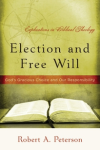
by Robert A. Peterson
Election and Free Will helps Christians who believe in a Reformed view of predestination to better understand their faith. Robert A. Peterson traces Scripture’s teaching on election through the Bible and explains the doctrine of free will. He also tackles objections to predestination and concludes with applications of this neglected biblical teaching.
See more study materials at: www.KennethGentry.com
Classic dispensationalists are aware of their own distinctive differences, as well. Ryrie even comments: “Perhaps the issue of premillennialism is determinative [for dispensationalism]. Again the answer is negative, for there are those who are premillennial who definitely are not dispensational. The covenant premillennialist holds to the concept of the covenant of grace and the central soteriological purpose of God. He retains the idea of the millennial kingdom, though he finds little support for it in the Old Testament prophecies since he generally assigns them to the church. The kingdom in his view is markedly different from that which is taught by dispensationalists since it loses much of its Jewish character due to the slighting of the Old Testament promises concerning the kingdom.” Ryrie even argues for “The Necessity of Dispensationalism” over against premillennialism.
Allis offers us a helpful eschatological sorting device, which Adams modifies. It works quite well in classifying the three basic millennial positions. Two questions tend to sort the positions into one of the three most basic schools. These questions are:
(1) What is the chronology of the kingdom?
(2) What is the nature of the kingdom?
The chronological question focuses on the timing of Christ’s second advent in relation to the kingdom’s establishment. If his coming is before the kingdom, then the position is premillennial; if it is after the kingdom, then it may be either amillennial or postmillennial. The question regarding the nature of Christ’s kingdom highlights its historical character. If the kingdom will have a radical, objective, transforming influence in human culture, it is either premillennial or postmillennial; if it will not, it is amillennial.









January 21, 2016
POSTMILLENNIAL BEGINNINGS
 PMT 2016-006 by Kenneth L. Gentry, Jr.
PMT 2016-006 by Kenneth L. Gentry, Jr.
This is my second installment on the question about the origins of postmillennialism. Many dispensationalists dismiss postmillennialism as a modern novelty. In my last article I pointed out that all eschatological development is only gradually understood over time. In this article I will show the seed beginnings of postmillennialism in antiquity.
As far as our preserved writings go, premillennialism finds slightly earlier development (especially in Irenaeus, A.D. 130-202). Yet theologian Donald G. Bloesch notes that “postmillennialism was already anticipated in the church father Eusebius of Caesarea” (A.D. 260-340) (Bloesch, Essentials of Evangelical Theology [San Francisco: Harper and Row, 1979], 2:192). Renowned historian Philip Schaff traces it back even farther, observing that Origen (A.D. 185-254) “expected that Christianity, by continual growth, would gain the dominion over the world.” (Schaff, History of the Christian Church, 5th ed. [Grand Rapids, Mich.: Eerdmans, rep. 1910], 2:591, cp. 122. )
He Shall Have Dominion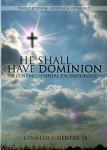
(paperback by Kenneth Gentry)
A classic, thorough explanation and defense of postmillennialism (600+ pages). Complete with several chapters answering specific objections.
See more study materials at: www.KennethGentry.com
Two other prominent church fathers whose historical confidence appears to express a nascent postmillennialism are Athanasius (A.D. 296-372) and Augustine (A.D. 354-430). These are giants of Christian orthodoxy.
Consider just one statement from Athanasius. The gospel’s great progress is expected, according to Athanasius’ view of Scripture (Isa 11:9; Mt 28:19; Jn 6:45): “And then, from Dan to Beersheba was the Law proclaimed, and in Judea only was God known; but now, unto all the earth has gone forth their voice, and all the earth has been filled with the knowledge of God, and the disciples have made disciples of all the nations, and now is fulfilled what is written, ‘They shall be all taught of God’” (Athanasius, Four Discourses Against the Arians 59:8). This is postmillennial in sentiment.
Turning to Augustine, Wendy Zoba notes, Augustine teaches that history “would be marked by the ever-increasing influence of the church in overturning evil in the world before the Lord’s return” (Zoba, “Future Tense” Christianity Today [October 2, 1995]: 20). This would eventually issue forth in a “future rest of the saints on earth” (Augustine, Sermon 259:2) “when the Church will be purged of all the wicked elements now mixed among its members and Christ will rule peacefully in its midst.” (Cited in Brian E. Daley, The Hope of the Early Church: A Handbook of Patristic Eschatology [Cambridge: University Press, 1991], 133). This early incipient postmillennialism contains the most basic element of the later developed system: a confident hope in gospel victory in history prior to Christ’s return.
Judaic Baptism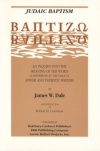
by James W. Dale
An academic study of the Greek word for “baptism.” Surveys Josephus, Philo, Sirach, church fathers, 2 Maccabees, and more. Provides insights into the study of words in their contexts. Explodes the view that the Greek word demands immersion.
See more study materials at: www.KennethGentry.com
We may also reference Augustine’s comments on Psalm 2. Regarding the Lord laughing at the nations (Ps 2:4) he writes: “it is to be understood of that power which he giveth to His saints, that they seeing things to come, namely, that the Name and rule of Christ is to pervade posterity and possess all nations.” At v. 7 he writes: “‘Ask of Me,’ may be referred to all this temporal dispensation, which has been instituted for mankind, namely, that the ‘nations’ should be joined to the Name of Christ, and so be redeemed from death, and possessed by God. ‘I shall give Thee the nations for Thine inheritance,’ which so possess them for their salvation, and to bear unto Thee spiritual fruit.” (Augustine in The Post-Nicene Fathers, 8:3)
Conclusion
Dispensationalists — who like to link themselves to historic premillennialism — are clearly wrong in their views of the recency of postmillennialism. Actually their
own system (created by John Nelson Darby in 1830) is the latest of the evangelical schools of eschatology.








January 18, 2016
ESCHATOLOGICAL DEVELOPMENT
 PMT 2016-005 by Kenneth L. Gentry, Jr.
PMT 2016-005 by Kenneth L. Gentry, Jr.
Many Christians, particularly dispensationalists, write-off postmillennialism as a modern theological construct. Nothing could be further from the truth. Multi-million-selling dispensationalist populist Hal Lindsey confidently declares: “There is no evidence of the distinctive teachings of Postmillennialism earlier than the seventeenth century” (Lindsey, Road to Holocaust [New York: Bantam, 1989], 29). Dispensational theologian Charles F. Baker agrees: “Its advocates admit that it was first taught in the seventeenth century” (Baker, Dispensational Theology [Grand Rapids: Grace Bible College, 1971], 623).
To make matters worse, many parrot the view that we may trace postmillennialism back to Daniel Whitby in 1703. Major dispensationalist theologian, Lewis S. Chafer wrote that Whitby was “the originator of what is known as postmillennialism.” (Chafer, Systematic Theology [Dallas, Tex.: Dallas Seminary Press, 1947], 4:280-281.) Present-day dispensational populist Mal Couch puts in the Bible notes of Tim LaHaye’s Prophecy Study Bible (p. 1530): “This view was first propagated by Daniel Whitby (AD 1638-1726), a Unitarian.”
This position — though widely cited — is quite erroneous. Let’s see how this is so.
The Beast of Revelation
by Ken Gentry
A popularly written antidote to dispensational sensationalism and newspaper exegesis. Convincing biblical and historical evidence showing that the Beast was the Roman Emperor Nero Caesar, the first civil persecutor of the Church. The second half of the book shows Revelation’s date of writing, proving its composition as prior to the Fall of Jerusalem in A.D. 70. A thought-provoking treatment of a fascinating and confusing topic.
For more study materials, go to: KennethGentry.com
We must realize, in the first place, that the early creedal formulations of Christianity provide only the most rudimentary elements of eschatology. For instance, the Apostle’s Creed simply affirms: “He ascended into heaven; and sitteth on the right hand of God the Father Almighty; from thence he shall come to judge the quick and the dead,” and a belief “in the resurrection of the body; and the life everlasting.” The eschatology of the Nicene Creed makes only very slight advances, asserting that he “ascended into heaven, and sitteth on the right hand of the Father; and he shall come again, with glory, to judge the quick and the dead; whose kingdom shall have no end.”
Both amillennialism and postmillennialism fit comfortably within these and other ancient creedal affirmations. Premillennialism’s fit is a bit more awkward, however, due to its requiring two separate resurrections and two distinct judgments rather than general ones involving all men simultaneously. Consequently, as classic dispensationalist Robert P. Lightner admits: “None of the major creeds of the church include premillennialism in their statements” (Robert P. Lightner, The Last Days Handbook: A Comprehensive Guide to Understanding the Different Views of Prophecy [Nashville: Thomas Nelson, 1990], 158.)
In fact, not one of the millennial views is expressly affirmed by any early creed as the orthodox position. This is not surprising in that, as evangelical theologian Millard J. Erickson explains, “all three millennial positions have been held virtually throughout church history.” (Millard J. Erickson, Christian Theology [Grand Rapids: Baker, 1985], 3:1207).
I Will Be Your God
by T. M. Moore
This book is dedicated to encouraging such an outlook on life. It does so by promoting a better understanding of the nature, meaning, and implications of living in God’s covenant.
For more study materials, go to: KennethGentry.com
This noted, we should expect to find a gradual development of the millennial schemes, rather than a fully-functioning system in early Christian history. Indeed, leading dispensationalist theologian John F. Walvoord confesses when defending dispensationalism: “It must be conceded that the advanced and detailed theology of pretribulationism is not found in the Fathers, but neither is any other detailed and ‘established’ exposition of premillennialism. The development of most important doctrines took centuries” (John F. Walvoord, The Rapture Question [Grand Rapids: Zondervan, 1957], 52).
Nevertheless, we may look into early Christian history and find: Postmillennial Beginnings. But I will not begin that article until my next blog!









Kenneth L. Gentry Jr.'s Blog
- Kenneth L. Gentry Jr.'s profile
- 85 followers











